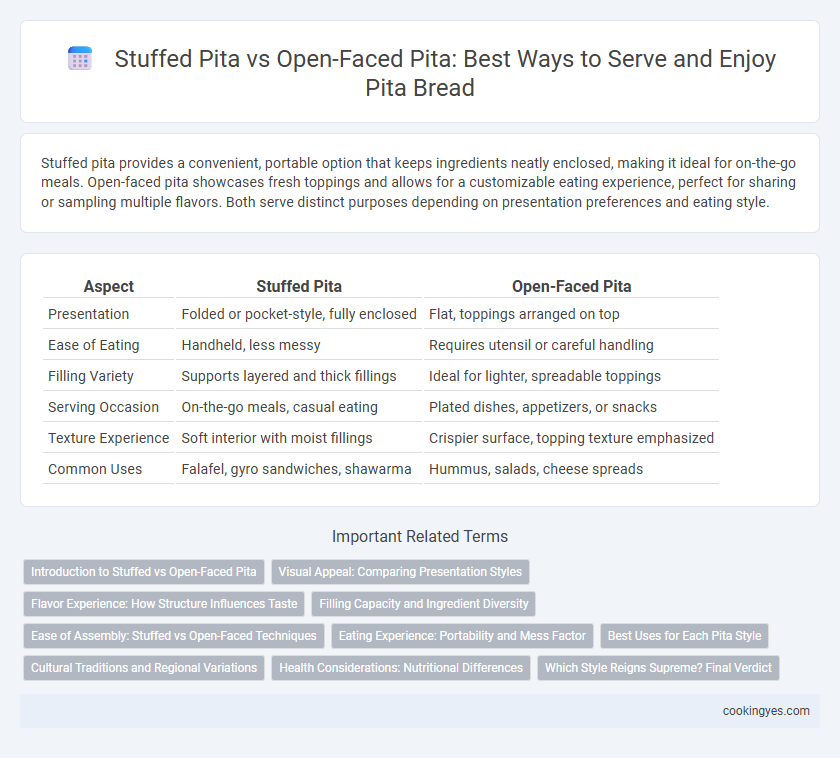Stuffed pita provides a convenient, portable option that keeps ingredients neatly enclosed, making it ideal for on-the-go meals. Open-faced pita showcases fresh toppings and allows for a customizable eating experience, perfect for sharing or sampling multiple flavors. Both serve distinct purposes depending on presentation preferences and eating style.
Table of Comparison
| Aspect | Stuffed Pita | Open-Faced Pita |
|---|---|---|
| Presentation | Folded or pocket-style, fully enclosed | Flat, toppings arranged on top |
| Ease of Eating | Handheld, less messy | Requires utensil or careful handling |
| Filling Variety | Supports layered and thick fillings | Ideal for lighter, spreadable toppings |
| Serving Occasion | On-the-go meals, casual eating | Plated dishes, appetizers, or snacks |
| Texture Experience | Soft interior with moist fillings | Crispier surface, topping texture emphasized |
| Common Uses | Falafel, gyro sandwiches, shawarma | Hummus, salads, cheese spreads |
Introduction to Stuffed vs Open-Faced Pita
Stuffed pita sandwiches encase fillings like falafel, grilled meats, or vegetables inside a pocket of soft, warm bread, creating a convenient, handheld meal ideal for on-the-go eating. Open-faced pita offers a flat, slightly crisp base topped with ingredients such as hummus, chopped salad, or shakshuka, allowing for an easy shareable dish with pronounced texture contrasts. Both styles highlight the versatility of traditional pita bread in Middle Eastern cuisine, catering to different eating preferences and presentation styles.
Visual Appeal: Comparing Presentation Styles
Stuffed pita offers a compact, handheld presentation that highlights the colorful filling peeking from the pocket, making it visually inviting and convenient for on-the-go eating. Open-faced pita showcases a vibrant array of toppings spread across the flatbread surface, emphasizing ingredient variety and texture diversity with each visible layer. Both styles enhance visual appeal by balancing color contrast and ingredient arrangement, appealing to different serving preferences and dining experiences.
Flavor Experience: How Structure Influences Taste
Stuffed pita traps fillings within its pocket, allowing flavors to meld and juices to saturate the bread, creating a harmonious and juicy bite. Open-faced pita exposes ingredients to air, enhancing texture contrast and preserving the freshness of each component. The structural difference directly influences taste by controlling moisture retention and flavor blending, with stuffed pita offering a richer, more integrated flavor experience while open-faced pita highlights individual ingredient profiles.
Filling Capacity and Ingredient Diversity
Stuffed pita offers a higher filling capacity by enclosing ingredients within a pocket, allowing for a diverse combination of meats, vegetables, sauces, and cheeses without spilling. Open-faced pita serves ingredients on top, which limits the amount and variety of fillings but provides a clear presentation of fresh toppings. Choosing between stuffed and open-faced pita depends on the desired balance between ingredient abundance and visual appeal.
Ease of Assembly: Stuffed vs Open-Faced Techniques
Stuffed pita offers a streamlined assembly process by allowing all ingredients to be placed inside the pocket, minimizing mess and ensuring even distribution of flavors. Open-faced pita requires precise layering of toppings on the exposed flatbread, which can demand more attention to presentation and balance. Both techniques cater to different serving preferences, with stuffed pitas emphasizing convenience and open-faced pitas highlighting visual appeal.
Eating Experience: Portability and Mess Factor
Stuffed pita offers a handheld eating experience that enhances portability and minimizes mess by enclosing fillings securely within the bread. Open-faced pita exposes ingredients, creating a more flavorful bite but increasing the likelihood of spills and a less convenient eating process. For on-the-go meals, stuffed pita is optimal, while open-faced pita suits casual settings where ease of eating is less critical.
Best Uses for Each Pita Style
Stuffed pita pockets are ideal for holding hearty fillings like gyro meat, falafel, or grilled vegetables, making them perfect for portable meals and handheld dining experiences. Open-faced pitas excel when layered with spreads, salads, or ingredients like hummus, tabbouleh, and roasted meats, allowing easy access for sharing or tasting a variety of flavors. Choosing stuffed or open-faced pita depends on whether the goal is convenience and mess-free eating or a communal and customizable presentation.
Cultural Traditions and Regional Variations
Stuffed pita, popular in Middle Eastern countries like Lebanon and Israel, reflects traditional culinary practices where fillings such as falafel, shawarma, or mixed salads are enclosed within the pocket, offering a convenient, portable meal. Open-faced pita, common in Mediterranean regions like Greece and Turkey, showcases toppings like hummus, grilled vegetables, or meats arranged on top, emphasizing communal dining and sharing. These regional variations highlight how cultural traditions influence the preparation and presentation of pita, shaping distinct eating experiences across the Mediterranean and Middle East.
Health Considerations: Nutritional Differences
Stuffed pita pockets often contain a balanced mix of protein, vegetables, and sauces, providing a nutrient-dense meal with controlled portion sizes. Open-faced pita servings allow for more customization in toppings but may lead to higher calorie intake due to added oils and spreads. Choosing whole wheat pita can enhance fiber content and improve overall nutritional value in both serving styles.
Which Style Reigns Supreme? Final Verdict
Stuffed pita offers a convenient, hand-held meal packed with fillings that blend flavors and textures inside a warm, pillowy pocket, making it ideal for on-the-go eating. Open-faced pita showcases a more artisanal presentation, with toppings arranged on a flatbread base, allowing for greater customization and visual appeal but requiring utensils for easy consumption. When comparing versatility, portability, and ease, stuffed pita reigns supreme as the preferred choice for quick, satisfying pita dishes.
Stuffed pita vs open-faced pita for serving Infographic

 cookingyes.com
cookingyes.com